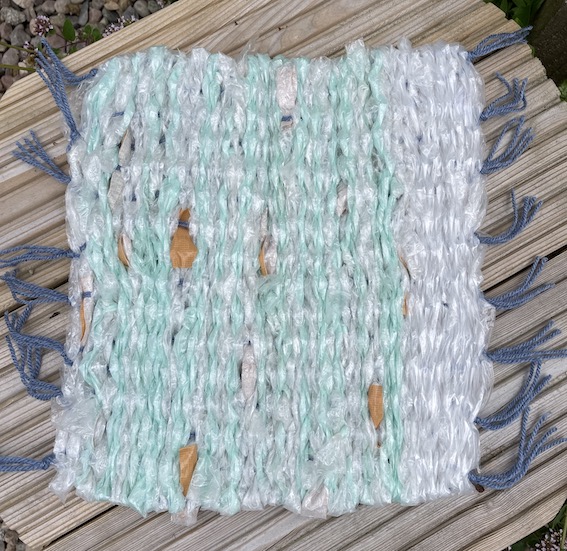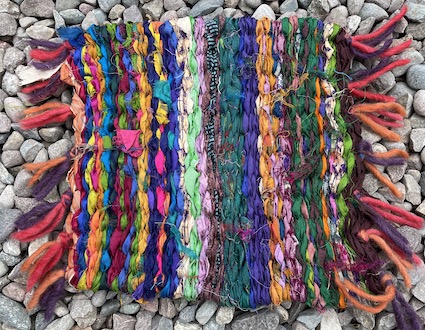Many years ago, my mum off-loaded all her unwanted fleeces onto me. I spent many happy hours experimenting and having fun exploring their potential for learning and play. She introduced me to peg looms which have “kid-friendly-must-do” written all over them. Below are some reasons why this craft is great for outdoor use and can be very sustainable if undertaken with a little thought.
Peg looms can sourced locally from sustainable wood supplies
You can buy British made peg looms from British companies using local sustainably grown wood. Alternatively you can make your own. Muddy Faces have a guide to making your own peg loom and offer rustic ones you can purchase. Alternatively an online search will enable you to find British manufacturers of peg looms.
Peg looms are easy to use with children of all ages and abilities
A child with poor dexterity or a young child in nursery can learn and see their creations grow. It’s easy to set one up in a den or shelter or indoor classroom and have children come and go from using it. Many years ago, when I worked in an outdoor centre in Canada, we had a loom set up. Every class made a simple rag rug during their week-long visit. In the children’s free time they could go to the loom and do as much or as little work on the rug as they wished. A similar set-up would work well in a class or nursery. Then the rug can be used in class or be raffled as a fund raiser. I have used peg looms with children with additional support needs.
Peg looms come in different sizes and can be used flexibly.
This means you can create large mats using a 60 peg loom or a tiny 3 peg scarf or wall hanging. You can also buy or make peg looms with different sizes of pegs and spaces between the pegs. If you have a large peg loom, you just remove the pegs you do not wish to use. This stops children getting confused as to which pegs can and can’t be used. Start with a quick small project with a few pegs and build up as children’s knowledge, skill and experience improves.
Below is my 24-peg loom. I’ve got a 12-peg one too. Basically it’s a wooden block with dowling stuck into it. This one has the pegs set quite far apart so it can deal with bulky material such as tufts of wool, long grass or strips of plastic.
The warp is the thread used to set up the loom and as the basis for weaving material into it. I used Hebridean wool. Because I was using the whole loom, it took almost a whole ball of wool. It needs to be strong wool, or string or other yarn that won’t easily break. You may have leftover wool in your art store that needs used up.

You may weave many different materials
You can use long green freshly cut grass, strips of unwanted plastic bags, strips of material that no longer can be used for anything else – a piece of clothing that is stained or worn out can be torn up or recycled into a useful product. Why not let your class explore different materials and see what works best? This is a living experiment.

I used fleece kindly donated by a sheep via a farmer. I took out the washed Hebridean fleece from one of the compression bags. Storing wool in compression bags is best otherwise they take up far too much storage space. It also stops moths from using the fleece as a home. You can use any washed fleece. Fleece is also available unwashed but you would need to consider the pros and cons of this when working with children and the state of the fleece. If you want a humorously serious book on the different sheep breeds to show children, I’d recommend Beautiful Sheep.
Many people tear off strips of fleece and weave them into the peg loom. This is quick, fun and simple. Sometimes, it was better to use a pair of carders but it just depends on the fleece.
Wool is woven in and out of the pegs, When you come to near the top of the pegs, you take them out, one at a time, pull the warp thread through a little and put the peg back in its hole. This video clip will give you an illustration of what’s involved. However, for children, keep to much smaller projects with less pegs. Here’s a close up look at what goes on…

Even with washed wool, I found the work to be messy. Bits of grass and gunk are still in the fleece and these get scattered. Tufts of wool fall off. At the very least it’s a shed job. If you are using super-posh mega-clean wool, then I’m sure it would work just fine in your living room or classroom if you don’t mind a lot of hoovering. Bear in mind that all tufts of wool can be added to a compost bin, if you have one.
Below my owls, Humphrey and Fluffykins, are modelling the final product.
Peg loom weaving can be a springboard into other explorations
It’s particularly important to help children understand how our lives, even in urban areas, are connected to the land. That every product we use or make comes from the earth and therefore thinking about the source of what we use or make, understanding the impact of our choices and decisions on people, places and more-than-human species matters. If wool is used, then naturally there is a farming link. Have a look at the range of peg loom wool seats I’ve made from different breeds of sheep. RHET have resources about sheep and wool, as does The Countryside Classroom.
Weaving is a traditional craft. Children can see if they can find other examples of weaving. For instance willow baskets, hazel fences, tree baskets and even seagrass baskets or rattan furniture commonly found indoors are all examples. If your class has a willow den or tunnel, they can learn how to weave the rods back into the structure. Historically, examples of weaving can be found going back thousands of years. All-in-all, weaving is a practical form of learning linking us to our past, present and future.

Above is an example of peg loom weaving I did with re-purposed sari silk. It took less than an hour for me to complete including threading up the peg loom. It would take children significantly longer though.
This blog post was originally published in September 2011.




















Trackbacks/Pingbacks